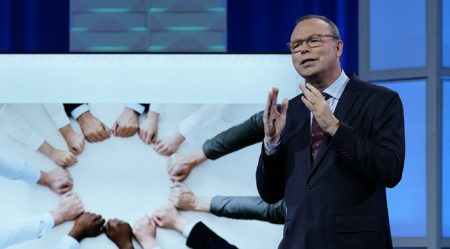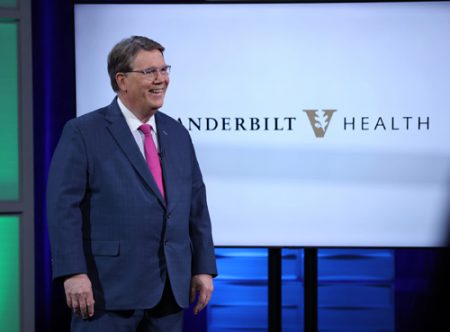by Holly Fletcher
The flexibility and adaptability of Vanderbilt University Medical Center has been center stage as the pressures of COVID-19 and ongoing strategic imperatives have transformed how and where care is delivered.
The pandemic accelerated VUMC’s digital initiatives while simultaneously building new lines of communication as teams collaborated to solve COVID-19 challenges, Medical Center leaders said during streaming of the May 2021 Leadership Assembly.

The response required to meet care demands as COVID-19 impacted personal and work lives demonstrated the depths of trust and adaptability at VUMC, said Jeff Balser, MD, PhD, President and Chief Executive Officer of VUMC and Dean of Vanderbilt University School of Medicine.
“COVID forced us into communication and relationship with people and teams at VUMC that were new to us to do things we never thought possible. And those interactions — formal and informal — are building new bridges of trust within the Medical Center.
“While I believe we already had more channels of trust and communication than many of our peers in health care, COVID has caused us to stretch to find new solutions — and in doing so, we’ve built many more relationships and channels of communication. All of these relationships are new bridges of trust,” said Balser.
Growth and geographic expansion
Establishing care in communities across the region is the result of multistage strategic growth — and it’s coinciding with the rise in digital communication that accelerated in the pandemic.
Over the last five years, since becoming financially and legally separate from Vanderbilt University, the Medical Center has grown from about 21,000 employees in 2016 to more than 28,000 employees today. While most are in Davidson County, a growing number go to work in surrounding counties — a signal that VUMC is making health care personal for more Tennesseans by keeping care close to home, said C. Wright Pinson, MBA, MD, Deputy CEO and Chief Health System Officer.

People have greater access to VUMC clinics in more neighborhoods and cities across Middle Tennessee than ever before.
- Over the course of 10 years, across all of VUMC’s hospitals, the number of licensed beds as grown from 1,065 to 1,965.
- In 2012, VUMC had 176 clinics. Now there are more than 500 in 175 unique locations.
- For example, women’s health and perinatal care clinics are popping up around the region to care for women and their babies close to home.
“You are improving the health of our region. Our team is also advancing medical science and educating tomorrow’s physician, nursing and allied health leaders in nationally recognized ways,” said Pinson. “We’ve adapted and re-engineered to keep pace with what our patients, the market and society want and deserve. We’ve accomplished so much together these past 10 years. We anticipate continued inpatient and outpatient growth in the future just as we have in the past.”
Digital milestones
Telehealth and digital tools, such as messaging and scheduling, surged during the pandemic — important benchmarks that will help patients stay in touch with the Medical Center. The rise of digital tools, and rapid adoption by staff and patients, reflect the flexibility that will be necessary as VUMC continues to respond to changing tech advances and preferences in care delivery, said Balser.
“We fundamentally changed how we deliver care through telehealth. Through necessity and with herculean efforts from our clinical teams, IT, and many others, we pivoted almost overnight. What we learned is that we could do far more for patients than we ever imagined, reaching people who are disabled, or have other difficulties traveling. We are receiving incredibly strong reviews from our patients, with overall satisfaction ratings in the top 20% when compared to other academic medical centers across the country,” said Balser.
The usage rates illustrate how VUMC is reaching more patients more frequently with digital communications tools, said Pinson, noting:
- There have been more than 3 million e-check-ins over the past four years.
- Patients scheduled nearly 270,000 appointments using online scheduling so far in this fiscal year. For comparison, in fiscal year 2019, there were 51,000 appointments scheduled online.
- In the last four years, there have been 77 million direct-to-patient messages sent.
- About 810,000 payments have been made using My Health at Vanderbilt so far this year — nearly double year over year.
Outlook
The resilience and flexibility on display during COVID-19 is showing up in continued improvement in performance, over a year into the pandemic, said Pinson. Virtual access to care, underway for five years but activated quickly during the pandemic, bolstered service performance metrics as society moved into isolation, he said.
Looking ahead, VUMC will continue to invest in its people through competitive market-based compensation.
The pandemic reshaped demand for care and with changes in the reimbursement environment, and initiatives to introduce value-based care models are on track, Pinson said.
There are now 11 MyHealth Bundles, including maternity care. Two new clinical pathways address lower back pain and diabetes — chronic issues that impact the quality of life and health of many patients.
“Just as our metrics are returning to normal, the health risks associated with the pandemic are also gradually declining. It is important to get vaccinated and wear masks at appropriate times. We know the community looks to us for accurate information and as role models,” said Pinson.
To view the May 5 Leadership Assembly please click here.












